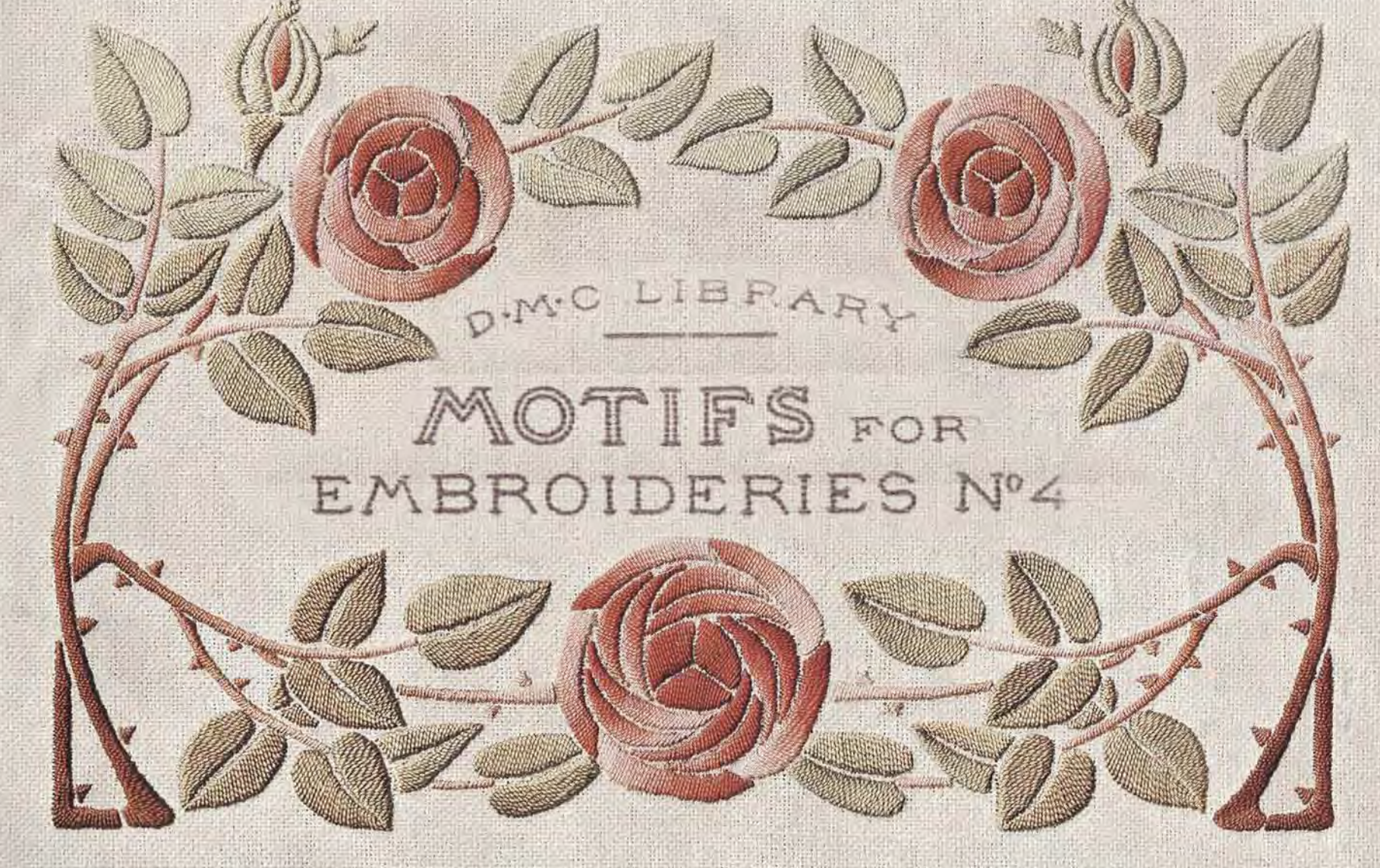Crewelwork Linen Gown – Planning & Materials
Now that I’ve committed to this ambitious project, I have to start breaking it down into manageable parts. The most important piece is the embroidery design itself.
As usual, I started by creating vector art of each of the motifs. This was a bit tricky, since I have to account for the folds of the fabric, as well as how it hangs when made up into a gown. Luckily, the museum had great photos of two of the motifs, and I could pull a third flat-ish image from the front view of the gown. The other two required a fair amount of guesswork.

Most of these motifs consist of an outline filled with rows of color. I settled on only tracing the lines that provide the overall shapes, but not the fills. For example, with the blue flower above I traced the dark blue lines, and the outermost pale blue lines. The body will be filled with as many rows of stitching as I can work inside that space.
The scale of a design is always a “best guess” scenario. In this case, I estimated the skirt length at center front to be 40″, which is about right for my height. My previous petticoats have been between 36″ and 40″ in length. Scaling the image up, that puts the motifs 12″ apart on center in each column, and 8″ apart on each row. This math is nice and tidy, so I went with it.

At that spacing, I placed each piece of vector art over the matching motif, and scaled it to size. Most were between 5-6″ tall. This is actually very close to the size of my samples – maybe 10% smaller. Which works well, because one of my samples felt too big. I needed more rows of stitching to fill the space than the original did. Sizing down should be just right.
I chose Au Ver a Soie “Fine d’Aubusson” wool thread for the embroidery. This is a fine, color-fast merino wool thread made by a family-owned business that’s been around since the early 1800s. I seems a bit larger and fuzzier than the original, but it’s one of the smallest wool threads available today. I’m using a size 130 tambour needle, which is a good fit for the wool. For the trim, I’ll use Soie Ovale on an inkle loom, with a yet-to-be-sourced gimp thread.
I sourced my linen from Dharma Trading, though I’m a tiny bit worried it’s too lightweight for the gown. It has a fine yet slubby look similar to the original fabric, but is much more sheer. Irish linen is gorgeous, but doesn’t have the slubs. Heavier linens just seemed to have chunkier thread, which also wasn’t what I wanted.
Honestly, the original looks almost exactly like an antique French linen sheet I have, but even if I could get enough sheets for the yardage, I would hate to use them for this! Plus they are heavy!! The top sheet I have weighs over 3 pounds.
For now, I’m continuing with what I have. Washing the linen seems to thicken it up just a bit, and I may decide to flat line it later to make it more opaque.

I’m starting with a panel about 30″ tall and the width of the fabric. I made a tambour frame with 3′ and 6′ slats, but the 6′ pieces are in storage for now. Using the 3′ slats, I have a max working space of roughly 30″ x 30″. Even so, that small section contains 16 motifs. I used Frixion markers to draw the grid and motifs. This also let me color-code the motifs to match the different colorways in the design.
While tambour is fast, several things are slowing me down with this piece. There are lots of sharp, tight points along the leaves and flowers. These require me to take a stitch at each point, which takes more time than continuous lines. There are also many color changes in a fairly small space, which also takes time for starting and stopping. The Fine d’Aubusson comes in hanks of 4 threads, so I have to cut shorter working lengths rather than using a continuous spool. This actually works out, since I need to cut and thread it on a needle for the points.
I have to keep in mind that I’m a beginner and I’m still feeling my way through every stitch. I know I’m going to make errors while I’m getting into the rhythm of the design and the technique. I know it will get easier and faster as I practice. I want to be good at this right now, but I’m trying to have some patience for the process.

Luckily, I have a plan so that these early efforts won’t go to waste. Instead, I can use them to make the trim on the front of the gown. This is strips of embroidery turned 90 degrees and pleated, which will hopefully help hide any errors.
It also gives me time to decide if the linen is too fine for the look of the gown. I can finish this panel and check the drape and overall look of the fabric before I commit to making the panels for the full gown. I don’t think lighter fabric will look out of place once it’s pleated.
I’m still waiting on a few colors of thread. My lightest and darkest greens are on backorder. I also changed my mind about a few colors once they arrived. I’m ordering brighter reds and a different orange. So to start, I’ll only be working on the blue, pink, and mauve sections of the design – which is still plenty!
Stay tuned for more details about the different motifs and my samples. If you missed it, my original inspiration post is here.

 Previous Post
Previous Post Next Post
Next Post

Love your tambour journey which has so many similarities to mine. I was self
Taught as not much info around when I started. Took your courses to see if you knew something I did not. Admire your work and patience to teach big time.
I have been curious about why one needs to thread a needle at points-assuming to lock stitch in place so it doesn’t distort after turning in another direction. I pull the last loop through to the back and pass the thread through to lock in place. No idea where I learned that method. I hate corners. They take so long. If possible I form a tiny stitch and hope that does the trick but it is the lazy way and never as good. I need to revisit the needle method as I think it was taught in one of your courses but I did not take the time to figure it out- well I tried but I am always on the fly so better to say I did not have the patience to figure it out.
All of my tambour is for regency clothing. Quite the struggle
In men’s waistcoats to find a strong , no fuzzing thread. Madeira fuzzes. No idea if dmc fuzzes. I have done a few garments using one strand. Wish it was a tiny bit thicker. Two strands is too thick and nasty and the needle can easily catch. No complaints so far about dmc fuzzing with wear. Lizabeth is the thread I use now but I would love to know of a thread that would fill in better. Lizabeth is tight and strong but does not spread to fill in the chain stitch . Limited colours. With waistcoats there is a lot of abrasion as
They typically wear
Them
For balls where there is a lot of movement. Any thread tips would be appreciated.
Embroidery for garments that you wear is very different from embroidery to frame and put in the wall. Expect in the day a lot of silk was used. Have not found one yet
But it is so hard when you can’t shop local for supplies and colours.
Waiting to see this gown
Finished.
Charlene Roberts